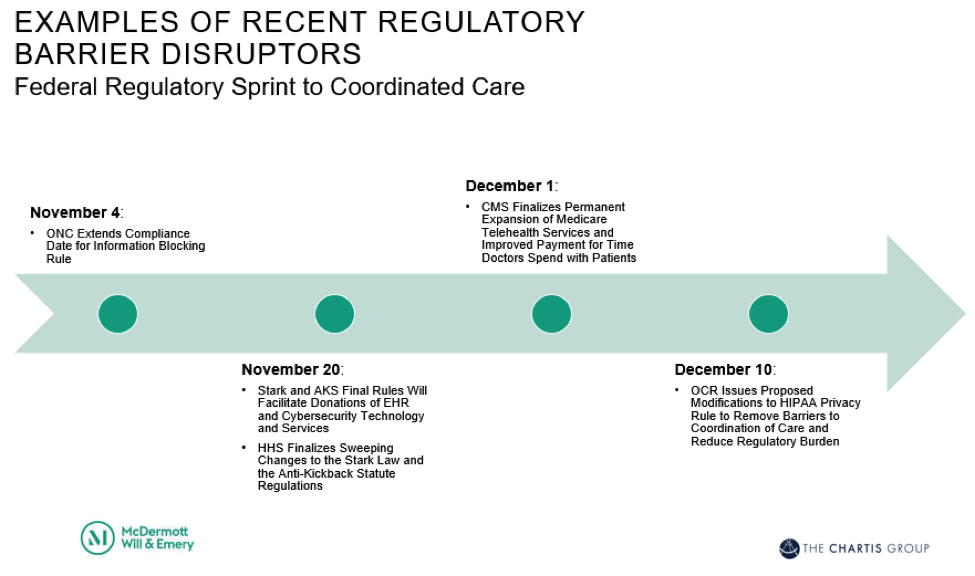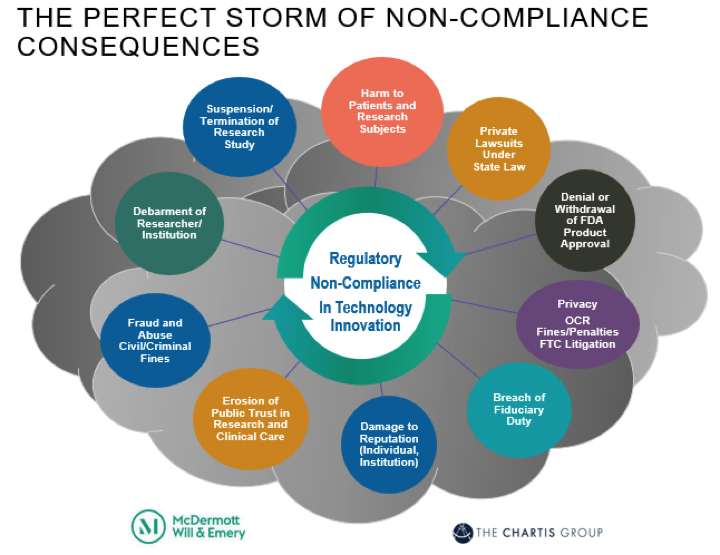The healthcare industry has readily embraced the concept of the “digital front door,” a digital framework that aims to democratize care access for an improved experience and better outcomes while reducing costs and streamlining care delivery. COVID-19 may have catalyzed the industry’s shift to digitally enabled care, but many of the solutions and delivery channels created were not built with sustainability and longer-term impact in mind.
For patients, however, one of the biggest, ever-present points of frustration is with the healthcare system’s extreme fragmentation. Care silos and data/technology silos abound, which often results in a disjointed healthcare experience with little coherence and thus, challenged to deliver value. Digital health tools and technology have the potential to dramatically improve the care experience, but to do so will require purposeful coordination and planned architecture.
How can we build a healthcare system that can, will, and must open this digital front door, while ensuring that patients and providers can both navigate their way through it, and importantly, find a connected, accessible, easy-to-navigate experience once on the other side? What are the legal imperatives and regulatory considerations that solutions developers, employers, health plans and providers need to consider when creating and engaging with an increasingly digital system? And who is responsible for building the necessary architecture to make a digitally driven care experience a reality?
Employers Increasingly Turning to Digital Tools to Better Serve Targeted Populations
With many U.S. adults covered by employer-sponsored health plans, employers continue to play a critical role in providing healthcare coverage and facilitating care delivery in the country—and healthcare purchasers today are invested in implementing the right kinds of solutions and options that will deliver the most value for their employee populations.
Despite existing contracts with carriers/plans and the contracts that carriers then have with providers, employers are increasingly adding digital solutions to their benefits suites, including those for targeted populations (e.g., diabetes support solutions, mental health solutions, etc.). However, employers have also seen how value can be left on the table with these systems and digital solutions, especially when fragmented, and even more so if employees are unaware or unclear on how to best utilize them.
For this reason, there has been a growing interest in and demand for concierge solutions to tie the myriad disparate offerings and channels together, helping to ensure employees are both aware of the healthcare services and benefits available to them and can easily navigate their engagement.
Communications platforms and holistic care management tools are playing a chief role in driving awareness of available services while enabling employees to act on their health. For example, WELL, a two-way digital solution that unifies the full lifecycle of patient interactions, provides a centralized healthcare communications hub for patients that is designed to solve the “last mile” problem in healthcare: Motivating patients to act. These kinds of engagement platforms will continue to be in high demand by employers striving to meet their goals of delivering better health at a lower cost for their population while ultimately helping reach employees where they are and in a way that meets their needs.
Moving Beyond the Digital Façade and Walking through the Door
Many healthcare organizations, employers, plans and solutions providers, while not their intent, end up building or implementing only a digital façade in their quest to transform the consumer care experience. A digital façade is a set of freestanding digital entry points that aren’t connected or integrated with care delivery capabilities. Other stakeholders are laser focused on building the digital front door itself, made up of digital entry points that are integrated with delivery assets, simplifying access to traditional care delivery. But the end goal for the industry, however, and all stakeholders playing a role in enabling digital care delivery, should be a digitally-transformed care experience: Reimagined care delivery across a unified digital and digitally-enabled enterprise.
It’s not enough for providers, payers, employers and solutions developers to simply build or implement the various digital health entry points; they must be interconnected across stakeholders, assets and platforms. Why? Taken alone, a digital façade of siloed entry points lacks the very integration that’s necessary to make an impact. In this common scenario, digital elements are effectively standing as an isolated façade, adjacent to legacy healthcare assets and capabilities, and without the connectivity required to achieve meaningful results, let alone drive transformation.
Standing Up a Business Model for Digital Transformation
Effectively standing up digital front doors and hallways in healthcare requires a dedicated business and operating model that accounts for the complex nature of digital projects and allows for agile, iterative updates. Organizations must identify and deploy baseline technical solutions and capabilities, while also creating shared organizational definitions of what “digital” truly means, in a way that clearly articulates project objectives and benefits, and provides a clear workflow for effective rollout and activation.
From virtual care platforms, mobile apps, CRM systems and remote patient monitoring (RPM) solutions, to enterprise analytics and technical architecture, each of these digital capabilities and channels must be developed using a business model that is specific to digital business initiatives, which should account for:
- Understanding consumer and stakeholder longitudinal needs and expectations.
- Explicit transformation value-creation quantification, timing, and requirements.
- Detailed implementation rollout plans, roadmaps, and mitigation steps.
- Long-term transformation “success” goals and interim progress performance metrics.
Organizations must also have a clearly defined and empowered governance and operating structure in place at the enterprise level to ensure proper oversight of digital projects while enabling swift execution and improvement. For example, organizations should have executive champions and individuals charged with overseeing the implementation of specific digital projects and dedicated teams focused on digital program design, launch, optimization and user experience.
Having the right functional support teams (e.g., IT, legal, finance, clinical) in place is also a necessity, as well as having teams focused on agile program development and real-time program performance tracking. When building digital doorways, it’s also crucial to have strategies and capabilities in place to define success and measure outcomes at every stage, including when navigating vendor relationships.
Navigating Legal and Regulatory Considerations when Building a Digital Gateway
As more and more organizations seek to build out their digital landscapes, there are a variety of legal, clinical, operational considerations and accompanying regulations that must be carefully evaluated to walk through the doorway as intended and achieve substantive, lasting transformation, including:
- Medicare reimbursement: Coverage requirements and limitations.
- Coding and billing compliance: Keeping pace with rule changes, particularly with respect to telemedicine, RPM and audio-only care services.
- Scope of practice, geographical boundaries, and professional licensure laws (e.g., licensure and other requirements for the delivery of virtual care).
- Federal and state privacy and security standards.
- Healthcare technology safety and efficacy.
- FDA and Federal Trade Administration approvals and regulations: Pre-market approval of medical devices; regulation of marketing (e.g., product labeling, advertising, and promotional considerations).
- Care quality and patient safety compliance.
- Clinical and general reliance on consumer-generated data: Privacy and security standards and patient consent practices; content standards, marketing and promotional guidelines and restrictions, and requirements for procedures.
- Fraud and abuse: Prohibitions against fraud, abuse, and self-referral, and consumer fraud.
- Ethical standards (e.g., human subject research)
- Board responsibility and fiduciary duties
Medicare reimbursement for virtual care is just one example. COVID-19 prompted CMS to flip the longstanding site and geography restrictions for virtual care delivery on their heads to improve patient access and use. On December 1, 2020, CMS released the annual Physician Fee Schedule final rule (“Final Rule”), which expanded the use of telehealth services to Medicare beneficiaries that will be in effect even after the pandemic concludes.
Without proper due diligence, digital doorway construction can create the perfect storm of regulatory non-compliance, capable of derailing projects, incurring fines, harming patients, causing breaches of fiduciary duties, harming institutions, and terminating projects altogether.
Digital Doorway Construction in Action: Providence
Like many providers across the country, Providence saw a spike in virtual care in March 2020, just as the COVID-19 pandemic began. During that time, Providence’s approach to digital innovation proved to be one of the critical success factors in its ability to quickly stand up an effective, efficient digital front door to care.
As COVID-19 continued to increase demand for virtual services and digital care access, Providence’s platform approach to innovation helped in three ways: 1) it ensured digital applications and the supporting infrastructure were working together as one cohesive unit; 2) it enabled them to better match and manage supply and demand; 3) it helped patients both walk through the digital front door and better navigate the care hallways across an entire episode of care. In addition to improving workflows, driving care access, and more effectively matching and managing care, Providence has seen $30 million in net new revenue from their operationalized virtual care platform, with 30% of its patients being new to the organization.
From discovery to delivery and beyond, from a digital perspective, having a framework that ties the disparate technology components together is critical for healthcare organizations looking to build digital doorways and connected hallways in a way that is scalable and repeatable. The non-negotiable: Having the right legal framework and implementing an ongoing due diligence process across the construction continuum to maintain compliance and avoid the perfect storm.









